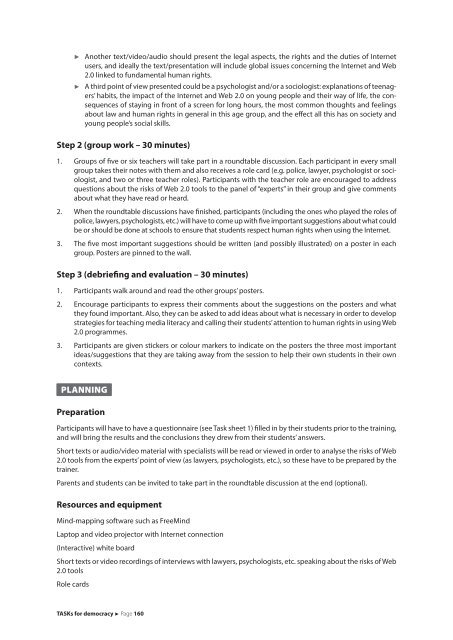TASKs for democracy
4NYw4W
4NYw4W
You also want an ePaper? Increase the reach of your titles
YUMPU automatically turns print PDFs into web optimized ePapers that Google loves.
Another text/video/audio should present the legal aspects, the rights and the duties of Internet<br />
users, and ideally the text/presentation will include global issues concerning the Internet and Web<br />
2.0 linked to fundamental human rights.<br />
A third point of view presented could be a psychologist and/or a sociologist: explanations of teenagers’<br />
habits, the impact of the Internet and Web 2.0 on young people and their way of life, the consequences<br />
of staying in front of a screen <strong>for</strong> long hours, the most common thoughts and feelings<br />
about law and human rights in general in this age group, and the effect all this has on society and<br />
young people’s social skills.<br />
Step 2 (group work – 30 minutes)<br />
1. Groups of five or six teachers will take part in a roundtable discussion. Each participant in every small<br />
group takes their notes with them and also receives a role card (e.g. police, lawyer, psychologist or sociologist,<br />
and two or three teacher roles). Participants with the teacher role are encouraged to address<br />
questions about the risks of Web 2.0 tools to the panel of “experts” in their group and give comments<br />
about what they have read or heard.<br />
2. When the roundtable discussions have finished, participants (including the ones who played the roles of<br />
police, lawyers, psychologists, etc.) will have to come up with five important suggestions about what could<br />
be or should be done at schools to ensure that students respect human rights when using the Internet.<br />
3. The five most important suggestions should be written (and possibly illustrated) on a poster in each<br />
group. Posters are pinned to the wall.<br />
Step 3 (debriefing and evaluation – 30 minutes)<br />
1. Participants walk around and read the other groups’ posters.<br />
2. Encourage participants to express their comments about the suggestions on the posters and what<br />
they found important. Also, they can be asked to add ideas about what is necessary in order to develop<br />
strategies <strong>for</strong> teaching media literacy and calling their students’ attention to human rights in using Web<br />
2.0 programmes.<br />
3. Participants are given stickers or colour markers to indicate on the posters the three most important<br />
ideas/suggestions that they are taking away from the session to help their own students in their own<br />
contexts.<br />
PLANNING<br />
Preparation<br />
Participants will have to have a questionnaire (see Task sheet 1) filled in by their students prior to the training,<br />
and will bring the results and the conclusions they drew from their students’ answers.<br />
Short texts or audio/video material with specialists will be read or viewed in order to analyse the risks of Web<br />
2.0 tools from the experts’ point of view (as lawyers, psychologists, etc.), so these have to be prepared by the<br />
trainer.<br />
Parents and students can be invited to take part in the roundtable discussion at the end (optional).<br />
Resources and equipment<br />
Mind-mapping software such as FreeMind<br />
Laptop and video projector with Internet connection<br />
(Interactive) white board<br />
Short texts or video recordings of interviews with lawyers, psychologists, etc. speaking about the risks of Web<br />
2.0 tools<br />
Role cards<br />
<strong>TASKs</strong> <strong>for</strong> <strong>democracy</strong> Page 160


